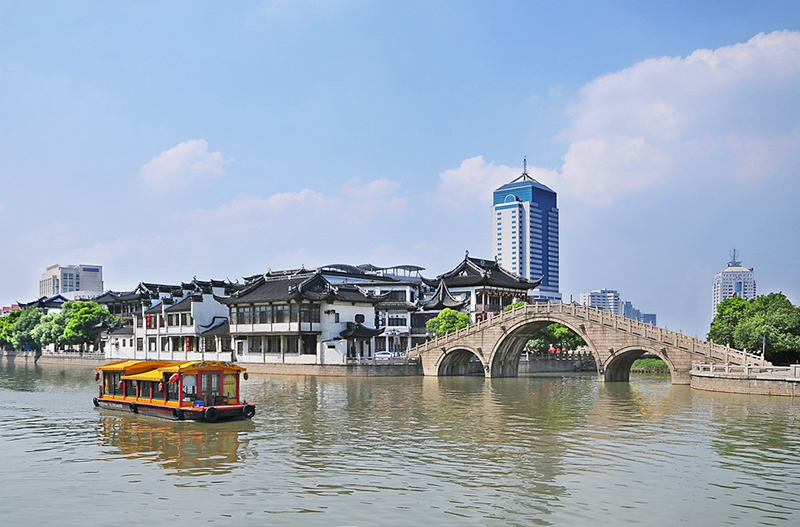As the only canal cultural tourist attraction in China with the ancient canal across downtown, the Ancient Canal & South Avenue Cultural Tourism Area of Changzhou is located in the South Avenue of downtown Changzhou.
Starting from Middle Jinling Road in the east and Huaide Bridge in the west and extending to the ancient canal in the south and West Yanling Road in the north, the cultural tourism area covers an area of 300,000m2, which contains five districts, namely, Comb Lane, Xiyingmen Ramparts, Minyuanli, Shuangguifang and Chongfa Temple. It was awarded the title of Class AAAA Tourist Attraction by the National Tourism Administration in 2011.
Characteristic Attractions
We warmly welcome tourists visiting the South Avenue to climb the ancient ramparts, travel along the ancient canal and enjoy the canal scenery, quest for stories of Changzhou in ancient and modern times and be enchanted by the cultural heritage of Changzhou in the past thousand years.
Jimei Hall
The current Jimei Hall is the renovated version of the original one. The Jimei Hall of the Zhuang Family is a cultural relic protection site of Changzhou. Jimei Hall is an ancient architectural complex of the Ming Dynasty of flush gable roof brick and wood structure, with a total of 6 rows of houses.
The name of Jimei Hall comes from the quote of Tso Chuan [a commentary on the Spring and Autumn Annals]: “the descendents shall inherit the virtues of the ancestors (“inherit” is pronounced as “Ji” and “virtures” is pronounced as “Mei” in Chinese). It is magnificent and beautifully constructed. There are crescent-shaped beams in the hall. The main entrance consists of 18 delicately carved Chinese style long picture windows, each with different patterns. The ground is a patchwork of hexagonal grey-green bricks, and the half brick wall is made of octagonal brick wall skirts.
At the corner of the stairs of the hollow square building of the Jimei Hall, there are multiple finely craved Ming Dynasty stone carvings, with various patterns including “red phoenix in morning sun”, “Master Keung Fishing”, “child-delivering Guanyin (a Bodhisattva)”, “deer bleating for spring” and so on. A gourd-shaped double dragon stone carving vase is placed in the middle of the patio, with a height of 2.5 meters. The craftsmanship of hollow carving and openwork carving can be called as the finest in Changzhou. There is a pair of screen walls with the pattern of two dragons frolicking with a pearl in the west side of the hall.
The Jimei Hall was the property of Zhuang Qiyuan (1559 – 1633). Zhuang Qiyuan, courtesy name Zhongru, literary name Hepo, became Jinshi (a successful candidate in the highest imperial examinations) together with his cousin Zhuang Tingchen in the thirty-eighth year of the reign of Emperor Wanli in the Ming Dynasty (1610). He assumed the office of county magistrate, department official, deputy head and head of affiliated department under the Ministry of Revenue, prefecture magistrate of Jiangxi Fuzhou, tribute grain transport supervisor of Zhili Tianjin, provincial judicial commissioner assistant of Shandong, Taipusi (a department in charge of horse management) deputy head (official with a rank of band four), etc. Disobedient to the eunuch Wei Zhongxian, Zhuang Qiyuan was demoted to garrison the border region at Shanhai Pass, thus becoming the ancestor of West Zhuang, the Zhuang Family in Changzhou. He wrote the Introduction to the Book of Songs and the Introduction to the Four Books (The Great Learning; The Doctrine of the Mean; The Analects of Confucius; Mencius) etc. together with his elder brother Zhuang Qimeng and cousin Zhuang Tingchen.
On February 26, 2008, Changzhou Municipal People’s Government listed Jimei Hall among the fourth batch of Changzhou cultural relic protection sites.
